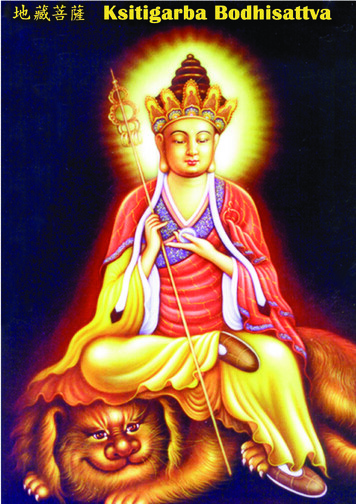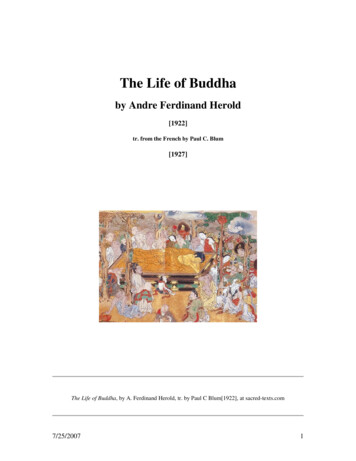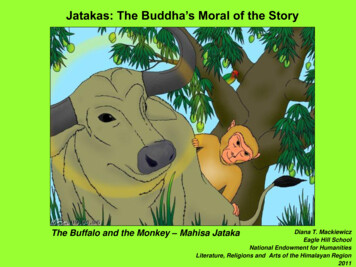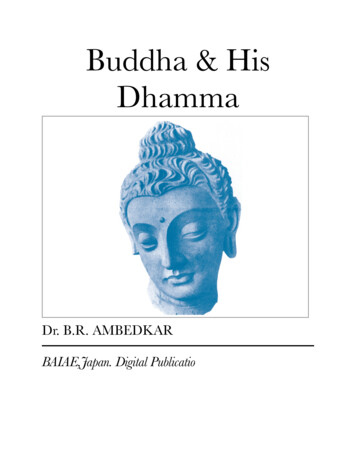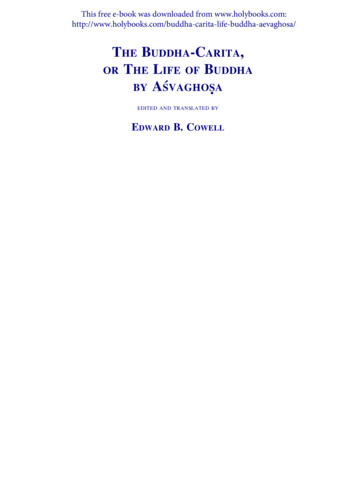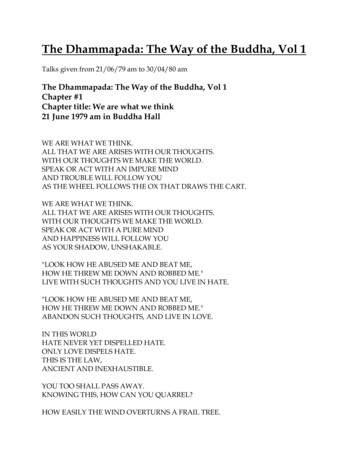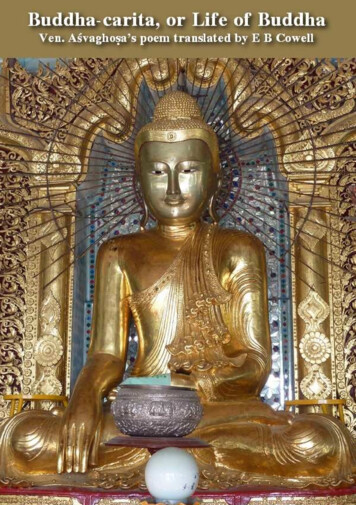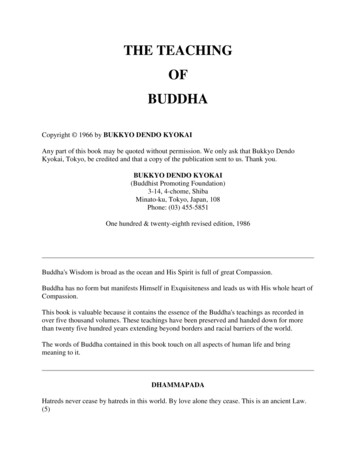
Transcription
THE TEACHINGOFBUDDHACopyright 1966 by BUKKYO DENDO KYOKAIAny part of this book may be quoted without permission. We only ask that Bukkyo DendoKyokai, Tokyo, be credited and that a copy of the publication sent to us. Thank you.BUKKYO DENDO KYOKAI(Buddhist Promoting Foundation)3-14, 4-chome, ShibaMinato-ku, Tokyo, Japan, 108Phone: (03) 455-5851One hundred & twenty-eighth revised edition, 1986Buddha's Wisdom is broad as the ocean and His Spirit is full of great Compassion.Buddha has no form but manifests Himself in Exquisiteness and leads us with His whole heart ofCompassion.This book is valuable because it contains the essence of the Buddha's teachings as recorded inover five thousand volumes. These teachings have been preserved and handed down for morethan twenty five hundred years extending beyond borders and racial barriers of the world.The words of Buddha contained in this book touch on all aspects of human life and bringmeaning to it.DHAMMAPADAHatreds never cease by hatreds in this world. By love alone they cease. This is an ancient Law.(5)
A fool who thinks that he is a fool is for that very reason a wise man. The fool who thinks that heis wise is called a fool indeed. (63)Though he should conquer a thousand men in the battlefield a thousand times, yet he, indeed,who would conquer himself is the noblest victor. (103)Though he should live a hundred years, not seeing the Truth Sublime; yet better, indeed, is thesingle day's life of one who sees the truth Sublime. (115)Hard is birth as man, Hard is the life or mortals, Hard is the hearing of the Sublime Truth, Hardis the appearance of a Buddha. (182)Not to do any evil, To cultivate good, To purify one's mind, -- This is the advice of the Buddhas.(183)There are no sons for protection, neither father nor even kinsmen; for him who is overcome bydeath no protection is there from kinsmen. (288)CONTENTSBUDDHAChapter One: Shakyamuni Buddha2I. The Life of The Buddha2II. The Last Teaching of The Buddha10Chapter Two: The Eternal and Glorified Buddha15I. His Compassion and Vows15II. Buddha's Relief and Salvation for us19III. The Eternal Buddha22Chapter Three: The Form of Buddha and His Virtues 25I. Three Aspects of Buddha's Body25II. The Appearance of Buddha29III. Buddha's Virtue32DHARMAChapter One: Causation38
I. The Fourfold Noble Truth38II. Causation41III. Dependent Origination42Chapter Two: The Theory of Mind-Only and TheReal State of Things46I. Impermanency and Egolessness46II. The Theory of Mind-Only49III. Real State of Things52IV. The Middle Way57Chapter Three: Buddha-Nature57I. The Mind of Purity65II. Buddha-Nature71III. Egolessness75Chapter Four: Defilements81I. Human Defilements81II. Man's Nature88III. Human Life90IV. Reality of Human Life95Chapter Five: The Relief Offered by Buddha102I. Amida Buddha's Vows102II. Amida Buddha's Land of Purity110THE WAY OF PRACTICEChapter One: The Way of Purification116I. Purification of the Mind116II. The Good Way of Behavior123III. Teaching in Ancient Fables134Chapter Two: The Way of Practical Attainment150I. Search for Truth150II. The Ways of Practice163
III. The Way of Faith176IV. Sacred Sayings184THE BROTHERHOODChapter One: Duties of the Brotherhood194I. Homeless Brothers194II. Lay Followers200Chapter Two: Practical Guide to True Way of Living212I. Family Life212II. The Life of Women222III. In Service230Chapter Three: Building a Buddha Land240I. The Harmony of Brotherhood240II. The Buddha's Land248III. Those Who Have Received Glory in Buddha's Land 253Source References259The AppendixesI. Brief History of Buddhism272II. Transmission of Buddha's Teaching282III. History of "The Teaching of Buddha"285IV. Index to "The Teaching of Buddha"287V. Sanskrit Glossary297VI. Anguttara Nikaya305Buddhist Promoting Foundation and Distribution of"The Teaching of Buddha"307BUDDHA
TOCCHAPTER ONESHAKYAMUNI BUDDHAITHE LIFE OF THE BUDDHA1. The Shakya clansmen dwelt along the Rohini River which flows among the southern foothillsof the Himalayas. Their king, Shuddhodana Gautama, established his capital at Kapilavastu andthere had a great castle built and ruled wisely, winning the acclaim of his people.The Queen's name was Maya. She was the daughter of the King's uncle who was also the kingof a neighboring district of the same Shakya clan.For twenty years they had no children. But on night Queen Maya had a strange dream, inwhich she saw a white elephant entering into her womb through the right side of her chest, andshe became pregnant. The King and the people looked forward with anticipation to to the birthof a royal child. According to their custom the Queen returned to her parents' home for the birth,and on her way, in the beautiful spring sunshine, she took a rest in the Lumbini Garden.2TOCAll about her were Ashoka blossoms. In delight she reached her right arm out to pluck abranch and as she did so a prince was born. All expressed their heart-felt delight with the gloryof the Queen and her princely child; Heaven and Earth rejoiced. This memorable day was theeighth day of April.The joy of the King was extreme and he named the child, Siddhartha, which means "Everywish fulfilled."2. In the palace of the King, however, delight was followed quickly by sorrow, for after severaldays the lovely Queen Maya suddenly died. Her younger sister, Mahaprajapati, became thechild's foster mother and brought him up with loving care.A hermit, called Asita, who lived in the mountains not far away, noticed a radiance about thecastle. Interpreting it as a good omen he came down to the palace and was shown the child. Hepredicted: "This Prince, if he remains in the palace, when grown up will become a great kingand subjugate the whole world. But if he forsakes the court life to embrace a religious life, hewill become a Buddha, the Savior of the world."
At first the King was pleased to hear this prophecy, but later he started to worry about thepossibility of his only son leaving the palace to become a homeless recluse.3TOCAt the age of seven the Prince began his lessons in the civil and military arts, but his thoughtsmore naturally tended to other things. One spring day he went out of the castle with his father.Together they were watching a farmer at his plowing when he noticed a bird descended to theground and carried off a small worm which had been turned up by the farmer's plough. He satdown in the shade of a tree and thought about it, whispering to himself:"Alas! Do all living creatures kill each other?"The Prince, who had lost his mother so soon after his birth, was deeply affected by the tragedyof these little creatures.The spiritual wound deepened day by day as he grew up; like a little scar on a young tree, thesuffering of human life became more and more deeply engrained in his mind.The King was increasingly worried as he recalled the hermit's prophecy and tried in everypossible way to cheer the Prince and to turn his thoughts in other directions. The King arrangedthe marriage of the Prince at the age of nineteen to the Princess Yashodhara. She was thedaughter of Suprahuddha, the Lord of Devadaha Castle and a brother of the late Queen Maya.4TOC3. For ten years, in the different Pavilions of Spring, Autumn and the Rainy Season, the Princewas immersed in rounds of music, dancing and pleasure, but always his thoughts returned to theproblem of suffering as he pensively tried to understand the true meaning of human life."The luxuries of the palace, this healthy body, this rejoicing youth! What do they mean tome?" he thought. "Some day we may be sick, we shall become aged; from death there is noescape. Pride of youth, pride of health, pride of existence -- all thoughtful people should castthem aside."A man struggling for existence will naturally look for something of value. There are twoways of looking -- a right way and a wrong way. If he looks in the wrong way he recognizesthat sickness, old age and death are unavoidable, but he seeks the opposite.
"If he looks in the right way he recognizes the true nature of sickness, old age and death, andhe searches for meaning in that which transcends all human sufferings. In my life of pleasures Iseem to be looking in the wrong way."4. Thus the spiritual struggle went on in the mind of5TOCthe Prince until his only child, Rahula, was born when he was 29. This seemed to bring things toa climax, for he then decided to leave the palace and look for the solution of his spiritual unrestin the homeless life of a mendicant. He left the castle one night with only his charioteer,Chandaka, and his favorite horse, the snow-white Kanthaka.His anguish did not end and many devils tempted him saying: "You would do better to returnto the castle for the whole world would soon be yours." But he told the devil that he did notwant the whole world. So he shaved his head and turned his steps toward the south, carrying abegging bowl in his hand.The Prince first visited the hermit Bhagava and watched his ascetic practices. He then went toArada Kalama and Udraka Ramaputra to learn their methods of attaining Enlightenment throughmeditation; but after practicing them for a time he became convinced that they would not leadhim to Enlightenment. Finally he went to the land of Magadha and practiced asceticism in theforest of Uruvilva on the banks of the Nairanjana River, which flows by the Gaya Village.6TOC5. The methods of his practice were unbelievably rigorous. He spurred himself on with thethought that "no ascetic in the past, none in the present, and none in the future, ever has practicedor ever will practice more earnestly than I do."Still the Prince could not realize his goal. After six years in the forest he gave up the practiceof asceticism. He went bathing in the river and accepted a bowl of milk from the hand of Sujata,a maiden, who lived in the neighboring village. The five companions who had lived with thePrince during the six years of his ascetic practice were shocked that he should receive milk fromthe hand of a maiden; they thought him degraded and left him.Thus the Prince was left alone. He was still weak, but at the risk of losing his life heattempted yet another period of meditation, saying to himself, "Blood may become exhausted,
flesh may decay, bones may fall apart, but I will never leave this place until I find the way toEnlightenment."It was an intense and incomparable struggle for him. He was desperate and filled withconfusing thoughts, dark shadows overhung his spirit, and he was beleaguered by7TOCall the lures of the devils. Carefully and patiently he examined them one by one and rejectedthem all. It was a hard struggle indeed, making his blood run thin, his flesh fall away, and hisbones crack.But when the morning star appeared in the eastern sky, the struggle was over and the Prince'smind was as clear and bright as the breaking day. He had, at last, found the path toEnlightenment. It was December eighth, when the Prince became a Buddha at thirty-five yearsof age.6. From this time on the Prince was known by different names: some spoke of him as Buddha,the Perfectly Enlightened One, Tathagata; some spoke of him as Shakyamuni, the Sage of theShakya clan; others called him the World-honored One.He went first to Mrigadava in Varanasi where the five mendicants who had lived with himduring the six years of his ascetic life were staying. At first they shunned him, but after they hadtalked with him, they believed in him and became his first followers. He then went to theRajagriha Castle and won over King Bimbisara who had always been his friend. From there hewent about the country living on alms and teaching men to accept his way of life.Men responded to him as the thirsty seek water and8TOCthe hungry food. Two great disciples, Sariputra and Maudgalyayana, and their two thousandfollowers, came to him.At first the Buddha's father, King Shuddhodana, still inwardly suffering because of his son'sdecision to leave the palace, remained aloof, but then became his faithful disciple.
Mahaprajapati, the Buddha's stepmother, and Princess Yashodhara, his wife, and all the membersof the Shakya clan began to follow him. Multitudes of others also became his devoted andfaithful followers.7. For forty-five years the Buddha went about the country preaching and persuading men tofollow his way of life. But when he was eighty, at Vaisali and on his way from Rajagriha toShravasti, he became ill and predicted that after three months he would enter Nirvana. Still hejourneyed on until he reached Pava where he fell seriously ill from some food offered byChunda, a blacksmith. Eventually, in spite of great pain and weakness, he reached the forest thatbordered Kusinagara.Lying between two large sala trees, he continued teaching his disciples until his last moment.Thus he entered into perfect tranquility after he had completed his work as the world's greatestteacher.9TOC8. Under the guidance of Ananda, the Buddha's favorite disciple, the body was cremated by hisfriends in Kusinagara.Seven neighboring rulers as well as King Ajatasutru demanded that the relics be dividedamong them. The People of Kusinagara at first refused and the dispute even threatened to end inwar; but under the advice of a wise man named Drona, the crisis passed and the relics weredivided among the eight great countries. The ashes of the funeral pyre and the earthen jar thatcontained the relics were also given to two other rulers to be likewise honored. Thus ten greattowers commemorating the Buddha were built to enshrine his relics and ashes.IITHE LAST TEACHING OF THE BUDDHA1. Beneath the sala trees at Kusinagara, in his last words to his disciples, the Buddha said:"Make of yourself a light. Rely upon yourself: do not depend upon anyone else. Make myteachings your light. Rely upon them: do not depend upon any other teaching.Consider your body: Think of its impurity. Know-
10TOCing that both its pain and its delight are alike causes of suffering, how can you indulge in itsdesires? Consider your 'self'; think of its transiency; how can you fall into delusion about it andcherish pride and selfishness, knowing that they must all end in inevitable suffering? Considerall substances; can you find among them any enduring 'self'? Are they not all aggregates thatsooner or later will break apart and be scattered? Do not be confused by the universality ofsuffering, but follow my teaching, even after my death, and you will be rid of pain. Do this andyou will indeed be my disciples."2. "My disciples, the teachings that I have given you are never to be forgotten or abandoned.They are always to be treasured, they are to be thought about, they are to be practiced. If youfollow these teachings you will always be happy."The point of the teachings is to control your own mind. Keep your mind from greed, andyou will keep your behavior right, your mind pure and your words faithful. By always thinkingabout the transience of your life, you will be able to resist green and anger, and will be able toavoid all evils."If you find your mind tempted and so entangled in greed, you must suppress and control thetemptation; be the master of your own mind.11TOC"A man's mind may make him a Buddha, or it may make him a beast. Misled by error, onebecomes a demon; enlightened, one becomes a Buddha. Therefore, control your mind and do notlet it deviate from the right path."3. "You should respect each other, follow my teachings, and refrain from disputes; you shouldnot, like water and oil, repel each other, but should, like milk and water, mingle together.""Study together, learn together, practice my teachings together. Do not waste your mind andtime in idleness and quarreling. Enjoy the blossoms of Enlightenment in their season and harvestthe fruit of the right path."
"The teachings which I have given you, I gained by following the path myself. You shouldfollow these teachings and conform to their spirit on every occasion.If you neglect them, it means that you have never really met me. It means that you are farfrom me, even if you are actually with me; but if you accept and practice my teachings, then youare very near to me, even though you are far away."4. "My disciples, my end is approaching, our parting is12TOCnear, but do not lament. Life is ever changing; none can escape the dissolution of the body. ThisI am now to show by my own death, my body falling apart like a dilapidated cart."Do not vainly lament, but realize that nothing is permanent and learn from it the emptiness ofhuman life. Do not cherish the unworthy desire that the changeable might become unchanging.""The demon of worldly desires is always seeking chances to deceiver the mind. If a viperlives in your room and you wish to have a peaceful sleep, you must first chase it out.""You must break the bonds of worldly passions and drive them away as you would a viper.You must positively protect your own mind."5. "My disciples, my last moment has come, but do not forget that death is only the end of thephysical body. The body was born from parents and was nourished by food; just as inevitableare sickness and death.""But the true Buddha is not a human body: -- it is Enlightenment. A human body must die,but the Wisdom of Enlightenment will exist forever in the truth13TOCof the Dharma, and in the practice of the Dharma. He who sees merely my body does not trulysee me. Only he who accepts my teaching truly sees me."
"After my death, the Dharma shall be your teacher. Follow the Dharma and you will be trueto me.""During the last forty-five years of my life, I have withheld nothing from my teachings. Thereis no secret teaching, no hidden meaning; everything has been taught openly and clearly. Mydear disciples, this is the end. In a moment, I shall be passing into Nirvana. This is myinstruction."14TOCCHAPTER TWOTHE ETERNAL AND GLORIFIED BUDDHAIHIS COMPASSION AND VOWS1. The Spirit of Buddha is that of great loving kindness and compassion. The great lovingkindness is the spirit to save all people by any and all means. The great compassion is the spiritthat prompts it to be ill with the illness of people, to suffer with their suffering."Your suffering is my suffering and your happiness is my happiness," said Buddha, and, justas a mother always loves her child, He does not forget that spirit even for a single moment, for itis the nature of Buddhahood to be compassionate."The Buddha's spirit of compassion is stimulated according to the needs of men; man's faith isthe reaction to this spirit, and it leads him to Enlightment, just as a mother realizes hermotherhood by loving her child; then the child, reacting to that love, feels safe and at ease.15TOCYet people do not understand this spirit of Buddha and go on suffering from the illusions anddesires that arise from their ignorance; they suffer from their own deeds accumulated through
worldly passions, and wander about among the mountains of delusion with the heavy burden oftheir evil deeds.2. Do not think that the compassion of the Buddha is only for the present life; it is amanifestation of the timeless compassion of the eternal Buddha that has been operative sinceunknown time, when mankind went astray due to ignorance.The eternal Buddha always appears before people in the most friendly forms and brings tothem the wisest methods of relief.Shakyamuni Buddha, born a Prince among his Shakya kinsmen, left the comforts of his hometo live a life of asceticism. Through the practice of silent meditation, he realized Enlightenment.He preached the Dharma (the teaching) among his fellow men and finally manifested it by hisearthly death.The working of Buddhahood is as everlasting as human ignorance is endless; and as the depthof ignorance is bottomless, so Buddha's compassion is boundless.16TOCWhen Buddha decided to break from the worldly life, he made four great vows: 1) To save allpeople; 2) To renounce all worldly desires; 3) To learn all the teachings; and 4) to attain perfectEnlightenment. These vows were manifestations of the love and compassion that arefundamental to the nature of Buddhahood.3. Buddha first taught himself to avoid the sin of killing any living creature, he wished that allpeople might know the blessedness of long life.Buddha trained himself to avoid the sin of stealing, he wished that all people might haveeverything they needed.Buddha trained himself to avoid ever committing adultery, he wished that all people mightknow the blessedness of a pure spirit and not suffer from insatiable desires.Buddha, aiming at his ideal, trained himself to remain free from all deception, he wished thatall people might know the tranquillity of mind that would follow in speaking the truth.He trained himself to avoid double-talk, he wished that all people might know the joy offellowship.
17TOCHe trained himself to avoid abusing others, and then he wished that all might have the serenemind that would follow by living in peace with others.He kept himself free from idle talk, and then wished that all might know the blessedness ofsympathetic understanding.Buddha, aiming at his ideal, trained himself to keep free from greed, and by this virtuous deedhe wished that all people might know the peacefulness that would go with this freedom.He trained himself to avoid anger, and he wished that all people might love one another.He trained himself to avoid ignorance, and he wished that all people might understand and notdisregard the law of causation.Thus Buddha's compassion embraces all people, and his constant consideration is for theirhappiness. He loves people as parents love their children and he wishes the highest blessednessfor them, namely, that they will be able to pass beyond this ocean of life and death.18TOCIIBUDDHA'S RELIEF AND SALVATION FOR US1. It is very difficult for the words spoken by Buddha from the far bank of Enlightenment toreach the people still struggling in the world of delusion; therefore Buddha returns to this worldHimself and uses His methods of salvations."Now I will tell you a parable," Buddha said. "Once there lived a wealthy man whose housecaught on fire. The man was away from home and when he came back, he found that hischildren were so absorbed in play, had not noticed the fire and were still inside the house. Thefather screamed, 'Get out, children! Come out of the house! Hurry!' But the children did notheed him.
"The anxious father shouted again. 'Children, I have some wonderful toys here; come out ofthe house and get them!' Heeding his cry this time, the children ran out of the burning house."This world is a burning house. The people, unaware that the house is on fire, are in danger ofbeing burned to death so Buddha in compassion devises ways of saving them.19TOC2. Buddha said: "I will tell you another parable. Once upon a time the only son of a wealthyman left his home and fell into extreme poverty.""When the father traveled far from home in search of his son, he lost track of him. He dideverything he could to find his son, but in vain.""Decades later, his son, now reduced to wretchedness, wandered near where his father wasliving""The father quickly recognized his son and sent his servants to bring the wanderer home; whowas overcome by the majestic appearance of the mansion. He feared that they were deceivinghim and would not go with them. He did not realize it was his own father.""The father again sent his servants to offer him some money to become a servant in their richmaster's household. The son accepted the offer and returned with them to his father's house andbecame a servant.""The father gradually advanced him until he was put in charge of all the property andtreasures, but still the son did not recognize his own father.""The father was pleased with his son's faithfulness,20TOC
and as the end of his life drew near, he called together his relatives and friends and told them:'Friends, this is my only son, the son I sought for many years. From now on, all my propertyand treasures belong to him.'""The son was surprised at his father's confession and said: 'Not only have I found my fatherbut all this property and treasure is now mine.'"The wealthy man in this parable represents Buddha, and the wandering son, all people.Buddha's compassion embraces all people with the love of a father for his only son. In that lovehe conceives the wisest methods to lead, teach and enrich them with the treasure ofEnlightenment.3. Just as rain falls on all vegetation, so Buddha's compassion extends equally to all people. Justas different plants receive particular benefits from the same rain, so people of different naturesand circumstances are blessed in different ways.4. Parents love all their children, but their love is expressed with special tenderness toward asick child.Buddha's compassion is equal toward all people, but it is expressed with special care towardthose who, because of their ignorance, have heavier burdens of evil21TOCand suffering to bear.The sun rises in the eastern sky and clears away the darkness of the world without prejudice orfavoritism toward any particular region. So Buddha's compassion encompasses all people,encouraging them to do right and guides them against evil. Thus, He clears away the darkness ofignorance and leads people to Enlightenment.Buddha is father in His compassion and a mother in His loving-kindness. In their ignoranceand bondage to worldly desire, people often act with excessive zeal. Buddha is also zealous, butout of compassion for all people. They are helpless without Buddha's compassion and mustreceive His methods of salvation as His children.IIITHE ETERNAL BUDDHA
1. Common people believe that Buddha was born a prince and learned the way to Enlightenmentas a mendicant; actually, Buddha has always existed in the world which is without beginning orend.As the Eternal Buddha, He has known all people and22TOCapplied all methods of relief.There is no falsity in the Eternal Dharma which Buddha taught, for He knows all things in theworld as they are, and He teaches them to all people.Indeed, it is very difficult to understand the world as it is, for, although it seems true, it is not,and, although it seems false, it is not. Ignorant people can not know the truth concerning theworld.Buddha alone truly and fully knows the world as it is and He never says that it is true or false,or good or evil. He simply portrays the world as it is.What Buddha does teach is this: "That all people should cultivate roots of virtue according totheir natures, their deeds, and their beliefs." This teaching transcends all affirmation andnegation of this world.2. Buddha teaches not only through words, but also through His life. Although His life isendless, in order to awaken greedy people, He uses the expedient of death."While a certain physician was away from home, his children accidentally took some poison.When the physician returned, he noticed their sickness and prepared an23TOC
antidote. Some of the children who were not seriously poisoned accepted the medicine and werecured, but others were so seriously affected that they refused to take the medicine.The physician, prompted by his paternal love for his children, decided on an extreme methodto press the cure upon them. He said to the children: "I must go off on a long journey. I am oldand may pass away any day. If I am with you I can care for you, but if I should pass away, youwill become worse and worse. If you hear of my death, I implore you to take the antidote and becured of this subtle poisoning." Then he went on the long journey. After a time, he sent amessenger to his children to inform them of his death.The children, receiving the message, were deeply affected by the thought of their father's deathand by the realization that they would no longer have the benefit of his benevolent care.Recalling his parting request, in a feeling of sorrow and helplessness, they took the medicine andrecovered.People must not condemn the deception of this father-physician. Buddha is like that father.He, too, employs the fiction of life and death to save people who are entangled in the bondage ofdesires.24TOCCHAPTER THREETHE FORM OF BUDDHA AND HIS VIRTUESITHREE ASPECTS OF BUDDHA'S BODY1. Do not seek to know Buddha by His form or attributes; for neither the form nor the attributesare the real Buddha. The true Buddha is Enlightenment itself. The true way to know Buddha isto realize Enlightenment.If someone sees some excellent features of Buddha and then thinks he knows Buddha, his isthe mistake of an ignorant eye, for the true Buddha can not be embodied in a form or seen byhuman eyes. Neither can one know Buddha by a faultless description of his attributes. It is notpossible to describe His attributes in human words.Though we speak of His form, the Eternal Buddha has no set form, but can manifest Himselfin any form. Though we describe His attributes, yet the Eternal Buddha has no set of attributes,but can manifest Himself in any and all excellent attributes.
25TOCSo, if one sees distinctly the form of Buddha, or perceives His attributes clearly, and yet doesnot become attached to His form or to His attributes, he has the capacity to see and knowBuddha.2. Buddha's body is Enlightenment itself. Being formless and without substance, it always hasbeen and always will be. It is not a physical body that must be nourished by food. It is aneternal body whose substance is Wisdom. Buddha, therefore, has neither fear nor disease; He iseternally changeless.Therefore, Buddha will never disappear as long as Enlightenment exists. Enlightenmentappears as the light of Wisdom that awakens people into a newness of life and causes them to beborn into the world of Buddha.Those who realize this become the children of Buddha; they keep His Dharma, honor Histeachings and pass them on to posterity. Nothing can be more miraculous than the power ofBuddha.3. Buddha has a three-fold body. There is an aspect of Essence or Dharma-Kay; there is
The words of Buddha contained in this book touch on all aspects of human life and bring meaning to it. DHAMMAPADA Hatreds never cease by hatreds in this world. By love alone they cease. This is an ancient Law. (5) A fool who thinks that he is a fool is for


